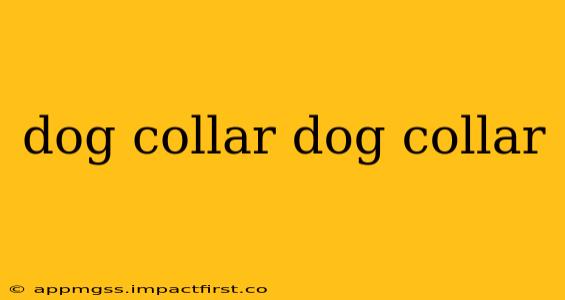Finding the Perfect Dog Collar: A Comprehensive Guide
Choosing the right dog collar might seem simple, but it's a crucial decision impacting your dog's comfort, safety, and overall well-being. From everyday walks to adventurous hikes, the perfect collar ensures your canine companion is secure and stylish. This guide delves into the essential factors to consider when selecting a dog collar, addressing common questions and offering expert advice.
What are the different types of dog collars?
There's a wide variety of dog collars available, each designed for specific purposes and dog breeds. Let's explore some of the most popular types:
- Standard Buckle Collars: These are the most common type, featuring a simple buckle closure. They're versatile, affordable, and suitable for most dogs.
- Martingale Collars: Designed to gently tighten when pulled, preventing dogs from slipping out while remaining comfortable. Ideal for dogs prone to slipping out of standard collars.
- Slip Collars: These collars consist of a single loop of material that tightens around the dog's neck when pulled. They are generally not recommended for everyday use due to potential for choking hazards. Use only under expert guidance.
- Head Halters/Harnesses: These are not technically collars but are often used in conjunction with or instead of them. They offer more control than a standard collar and are often used for training or managing strong pullers.
- Chain Collars: While historically common, these are increasingly discouraged due to potential for injury. Only use with extreme caution and professional guidance.
- Training Collars: These collars come in various styles and often incorporate electronic stimulation. Their use is highly controversial and requires careful consideration and professional training advice.
What material should I choose for my dog's collar?
The material of your dog's collar significantly impacts its durability, comfort, and longevity. Consider these options:
- Nylon: Durable, lightweight, and available in a vast array of colors and patterns. Easy to clean and relatively inexpensive.
- Leather: A classic choice, offering a sophisticated look and feel. Leather collars are durable but require more maintenance.
- Biothane: A synthetic material that is waterproof, durable, and easy to clean. It's a great option for active dogs or those living in wet climates.
- Rope: Often used for training or working dogs, rope collars are strong and durable but can be harsh on the dog's neck if not used properly.
How do I measure my dog for a collar?
Accurate measurement is critical to ensuring a comfortable and secure fit. To measure your dog for a collar, use a flexible tape measure and wrap it around your dog's neck, just behind the ears. Add 2 inches to the measurement to allow for comfortable movement and buckle closure.
How do I know if my dog's collar is too tight or too loose?
A properly fitted collar should allow for two fingers to fit comfortably between the collar and your dog's neck. If you can't fit two fingers, it's too tight. If the collar slides easily over the dog's head, it's too loose.
What features should I look for in a dog collar?
Beyond the material and type, several features can enhance your dog's comfort and safety:
- Reflective elements: Crucial for visibility during nighttime walks.
- Durable hardware: High-quality buckles and D-rings ensure the collar can withstand daily wear and tear.
- Comfortable padding: Especially beneficial for dogs with sensitive skin or thick fur.
- ID tags: Always attach appropriate identification tags for safe return if your dog gets lost.
Choosing the right dog collar is a vital part of responsible dog ownership. By considering the factors outlined above and prioritizing your dog's comfort and safety, you can select the perfect collar that ensures years of happy walks and adventures together. Remember to always supervise your dog while wearing any collar and consult a veterinarian or professional dog trainer if you have any concerns.
